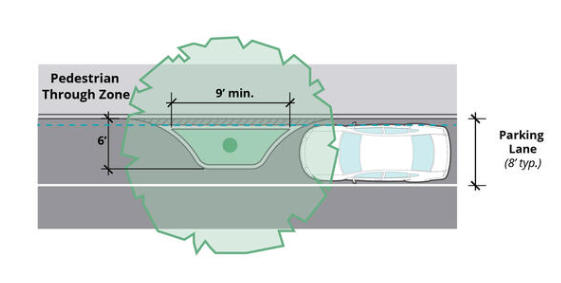 PedPDX and Pedestrian Design Guide - Implementation Update
Portland Bureau of Transportation, Portland Parks & Recreation, and Bureau of Environmental Services kick off a pilot project to increase tree canopy along streets that currently do not have space for street trees.
The Bureau of Environmental Services (BES) recently awarded the Portland Bureau of Transportation (PBOT) $500,000 from its "Percent for Green" program. The program collects a percent of development charges and uses that money to fund large-scale green infrastructure projects that provide broad benefits for watershed health and the community.
With the funding, PBOT will launch a pilot program to develop a policy framework for planting trees in the curb zone--the part of a street closest to the curb--in locations where there is not enough room on public right of way or private property to plant street trees. PBOT will work in collaboration with Portland Parks & Recreation’s Urban Forestry team, BES, and others in developing the framework.
In transportation planning projects, there often isn’t enough right-of-way adjacent to a sidewalk, so expanding into the parking zone may be the only option to get space for street trees.
The pilot program is focused on an area of East Portland that is lacking in tree canopy, and experiences higher temperatures during heat waves, which are expected to worsen as our climate changes. By creating space along roadways for large trees, the pilot intends to provide natural stormwater management and life-saving shade and cooling.
In the next two to three years, the pilot plans to install some street trees in the Brentwood-Darlington neighborhood, in locations where PBOT staff have determined an installation could be feasible. Brentwood-Darlington is an area of East Portland where many busy streets lack street trees.
 The Pedestrian Design Guide provides information on innovative tree planting treatments, such as Trees in the Curb Zone. This diagram is conceptual and not an engineering drawing.
The project is an early implementation project of the recently adopted Pedestrian Design Guide. One of the biggest things the project team heard from the public during the design guide process was the desire for innovative tree planting treatments. In preparation for the grant application, PBOT and Portland Parks & Recreation’s Urban Forestry staff conducted a citywide site analysis of potential corridors and are focusing the pilot on a cluster of streets in the Brentwood Darlington neighborhood. The area has hotter temperatures than other parts of the city, according to the urban heat index data. The site analysis considered existing conditions of the corridors. Areas with on-street parking may be good candidates for the pilot, compared with a street where a travel lane is built against the curb. A shortage of public right of way could indicate a need for the program. The location of underground and overhead utilities could make an installation impossible.
Through this project, the project team will further analyze the potential sites for implementation, select the final sites, conduct neighborhood outreach to engage communities in the project areas, and construct the tree plantings in the curb zone.
The project aims to plant a few street trees per block along a corridor (exact location to be determined) by repurposing on-street parking along corridors that currently do not have street trees or any space for street trees. Additionally, because trees can typically only be planted on one side of the street due to underground utility conflicts, the project will fund yard trees for the opposite side of the street, where street trees are not feasible. Project staff will work closely with adjacent property owners, residents, and businesses throughout the life of the project. Planning and engagement for this pilot project will take place over 2022-23 and construction will begin in 2024.
While the exact corridor is still being determined, there is an opportunity to tie into a current planning effort already underway in the Brentwood-Darlington neighborhood. The Lower SE Rising Area Plan, a project jointly led by PBOT and the Bureau of Planning and Sustainability (BPS), is already underway in Brentwood Darlington and has an existing community engagement process. This pilot project can utilize existing community engagement opportunities and work with the Lower SE Rising advisory committee to coordinate on these joint planning processes.
The city’s Pedestrian Master Plan (PedPDX) (2019) and the Pedestrian Design Guide set the policy direction for PBOT and bureau partners to explore more innovative tree treatments. PedPDX includes Action 8.6, which calls for PBOT to update right-of-way design standards to provide sufficient room for trees and recommends “providing trees within the curb zone intermittent with on-street parking” as a potential strategy.
This pilot project will allow staff to work through the design and technical implications of this treatment. Once there is a proof of concept, it will be easier to implement in other parts of the city, by allowing PBOT to go after additional funding, as well as have clear design standards from city engineers for capital and development projects.
Questions about this project, please contact:
|